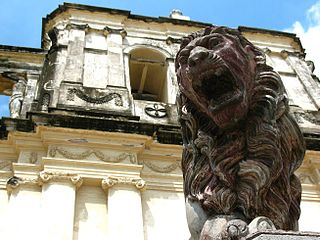
León is the second largest city in Nicaragua, after Managua. Founded by the Spanish as Santiago de los Caballeros de León, it is the capital and largest city of León Department. As of 2021, the municipality of León has an estimated population of 212,504.

Tlayacapan is the name of a town and a municipality located in the northeast part of Morelos state in central Mexico. It is located 60 km east from the state capital of Cuernavaca and about 1.5 hours south of Mexico City. It is a rural area, whose way of life has not changed much over the 20th century, with 90% of its population still partially or fully dependent on agriculture. The town has old mansions, houses with red tile roofs and streets paved with stones. Many ravines crisscross the area and are crossed by numerous stone bridges.

Spanish Colonial architecture represents Spanish colonial influence on New World and East Indies' cities and towns, and it is still being seen in the architecture as well as in the city planning aspects of conserved present-day cities. These two visible aspects of the city are connected and complementary. The 16th-century Laws of the Indies included provisions for the layout of new colonial settlements in the Americas and elsewhere.

The Franciscan missions of the Sierra Gorda of Querétaro in Mexico, are five missions built between 1750 and 1760, the foundation of the missions is attributed to Junípero Serra, who also founded the most important missions in California. They were declared a World Heritage Site by UNESCO in 2003.
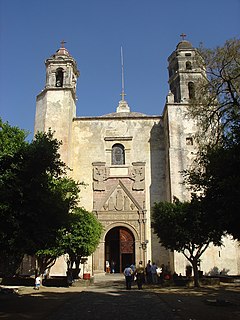
The Monasteries on the slopes of Popocatépetl are fifteen 16th-century monasteries which were built by the Augustinians, the Franciscans and the Dominicans in order to evangelize the areas south and east of the Popocatépetl volcano in central Mexico. These monasteries were recognized by the UNESCO as World Heritage Sites in 1994, because they served as the model for the early monastery and church buildings as well as evangelization efforts in New Spain and some points beyond in Latin America. These monasteries almost uniformly feature a very large atrium in front of a single nave church with a capilla abierta or open chapel. The atrium functioned as the meeting point between the indigenous peoples and the missionary friars, with mass for the newly converted held outdoors instead of within the church. This arrangement can be found repeated in other areas of Mexico as these friars continued to branch out over New Spain.
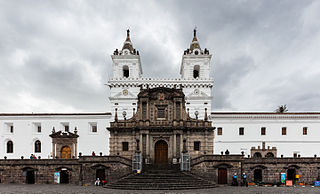
The Basilica and Convent of San Francisco, commonly known as el San Francisco, is a Catholic basilica that stands in the middle of the historic center of Quito, in front of the square of the same name. It is the oldest and most significant religious site in Ecuador. The structure is the largest architectural complex within the historic centers of all of South America, and for this reason it was known as "El Escorial of the New World". San Francisco is considered a jewel of continental architecture for its mixture of different styles combined throughout more than 150 years of construction. San Francisco is part of the UNESCO World Heritage Site "City of Quito".
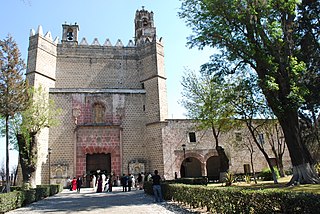
Huejotzingo (modern Nahuatl pronunciation is a small city and municipality located just northwest of the city of Puebla, in central Mexico. The settlement's history dates back to the pre-Hispanic period, when it was a dominion, with its capital a short distance from where the modern settlement is today. Modern Huejotzingo is located where a Franciscan monastery was founded in 1525, and in 1529, the monks moved the indigenous population of Huejotzingo to live around the monastery. Today, Huejotzingo is known for the production of alcoholic apple cider and fruit preserves, as well as its annual carnival. This carnival is distinct as it centers on the re-enactment of several historical and legendary events related to the area. The largest of these is related to the Battle of Puebla, with about 2, 000 residents representing French and Mexican forces that engage in mock battles over four days.
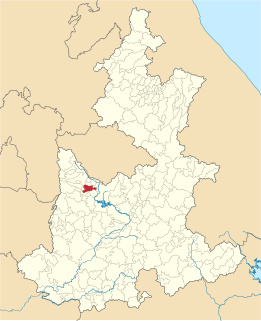
San Pedro Cholula is a municipality in the Mexican state of Puebla and one of two municipalities which made up the city of Cholula. The city has been divided into two sections since the pre Hispanic era, when revolting Toltec-Chichimecas pushed the formerly dominant Olmec-Xicallanca to the eastern side of the city in the 13th century. The new lords called themselves Cholutecas and built a new temple to Quetzalcoatl on the San Pedro side, which eventually eclipsed the formerly prominent Great Pyramid of Cholula, now on the San Andrés side. When the Spanish arrived in the 16th century, the city of Cholula was an important religious and economic center, but the center of power was on the San Pedro side, centered on what is now the main city plaza and the San Gabriel monastery. The division of the city persisted and San Pedro remained the more dominant, with Spanish families moving onto that side and the rest of the population quickly becoming mestizo. Today, San Pedro is still more commercial and less residential than neighboring San Andrés with most of its population employed in industry, commerce and services rather than agriculture. Although Cholula's main tourist attraction, the Pyramid, is in San Andrés, San Pedro has more tourism infrastructure such as hotels, restaurants and bars.

A capilla abierta or “open chapel” is considered to be one of the most distinct Mexican construction forms. Mostly built in the 16th century during the early colonial period, the construction was basically an apse or open presbytery containing an altar, which opened onto a large atrium or plaza. While some state that these were constructed by friars because the native peoples of that epoch were afraid to enter the dark confines of European-style churches, the more likely reasons for their construction were that they allowed the holding of Mass for enormous numbers of people and the arrangement held similarities to the teocallis or sacred precincts of pre-Hispanic temples. While open chapels can be found in other places in Spain and Peru, their systematic use in monasteries and other religious complexes, leading to a regularization of architectural elements, is only found in Mexico.

The Cuernavaca Cathedral is the Roman Catholic church of the Diocese of Cuernavaca, located in the city of Cuernavaca, Morelos, Mexico. The church and its surrounding monastery is one of the early 16th century monasteries in the vicinity of the Popocatepetl volcano inscribed as a World Heritage Site by UNESCO, built initially for evangelization efforts of indigenous people after the Spanish conquest of the Aztec Empire. By the 18th century, the church of the monastery began to function as the parish church of the city and in the late 19th century, it was elevated to the rank of a cathedral. Unlike many cathedrals in Mexico, this one does not face the city's main square, but rather is located just to the south, in its own walled compound, which it shares with a number of other structures. Unlike the other monastery structures from its time, the importance of this church provoked a number of renovation projects, the last of which occurred in 1957. This one took out the remaining older decorations of the interior and replaced them with simple modern ones. This renovation work also uncovered a 17th-century mural that covers 400 square metres (4,300 sq ft) of the interior walls and narrates the story of Philip of Jesus and twenty three other missionaries who were crucified in Japan.
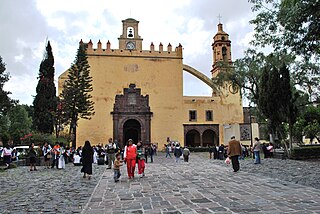
San Bernardino de Siena Church is the parish church of the borough of Xochimilco in Mexico City. The church and former monastery complex was built in the 16th century over a former pre Hispanic temple as part of evangelization efforts after the Spanish conquest of the Aztec Empire. Since its construction, it has been the center of much of Xochimilco’s history and social life, including ceremonies related to is famous image of the Child Jesus called the Niñopa. The interior of the church contains a rare 16th-century altarpiece in Plateresque style with no columns or other such supports. The only other altarpiece like it is in Huejotzingo, Puebla.

The Santa Monica Parish Church, commonly known as the Minalin Church, is a Baroque church, located in poblacion area of San Nicolas in Minalin, Pampanga, Philippines. The church, built during the Spanish era, was declared a National Cultural Treasure by the National Commission for Culture and the Arts and the National Museum of the Philippines on August 27, 2011, one of 37 churches in the country bestowed that honor.

The Church and Convent of San Nicolás de Tolentino is the Catholic church and parish house of the people of Actopan. It has always belonged to the Diocese of Tulancingo in Mexico. This church is located in the center of city. This colonial building is a monument of great architectural importance which has lasted until today in the State of Hidalgo.

Indochristian art, is a type of Latin American art that combines European colonial influences with Indigenous artistic styles and traditions.

Church of San Francisco Acatepec is a colonial religious building, characteristic of the Mexican Baroque architecture, especially recognized for its facade of Talavera mosaics combined with red brick. It is located in the town of San Francisco Acatepec in San Andrés Cholula, Metropolitan area of Puebla, in the state of Puebla, Mexico, and it was one of the first churches founded in the region.
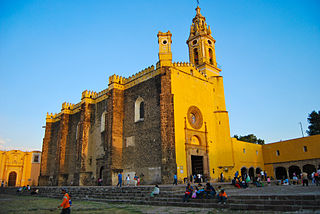
The San Gabriel Franciscan Convent or San Gabriel Friary is a church and friary in Cholula, Metropolitan area of Puebla City, Mexico.

Mendicant monasteries in Mexico were one of the architectural solutions devised by the friars of the Mendicant orders in the 16th century to the evangelization in the New Spain. The religious function of these buildings was thought for an enormous number of Amerindian indigenous people to evangelize although soon, due to the policy of reduction, the whole became the social center of the pueblos de indios, transmitting to them the civil modes of the West, Castilian, various arts and crafts, health, and even funeral services.
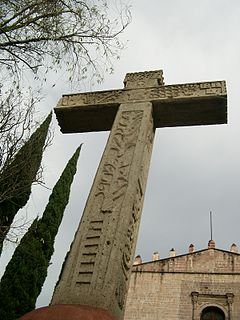
Atrial cross is the name given in the Mexican Colonial Conventual constructions, to a type of large cross made by the mendicant friars in the atriums of the churches, symbolically pointing to the center of the towns given their arrangement between the longitudinal and transverse axis of the atrium. As Arturo Schroeder Cordero cited in his article "The functions of the conventual atrium in the Mexican 16th century", the crosses were made in the beginning of wood and later in stone, since these functioned as lightning rods, as was the case of the huge atrial cross of the Convent of San José de los Naturales in Mexico City, which was split in two by a lightning in the early 16th century.

The Conventual Temple of Our Lady of Carmen or Templo conventual de Nuestra Señora del Carmen, currently known as the Church of the Virgin of Carmen or Iglesia de la virgen del Carmen, is a religious temple of Catholic worship that belongs to the ecclesiastical jurisdiction of the Archdiocese of Puebla de los Ángeles, under the invocation of the Virgen del Carmen. It is an example of the Baroque architecture of Puebla from the early seventeenth century, two of its chapels are of remarkable workmanship and decoration, as is the main nave that contains paintings such as the Santísima Trinidad de Cristóbal de Villalpando and its neoclassical altarpiece that houses the image of the Virgin, the work of the sculptor José Antonio Villegas Cora. The patronal feast is celebrated on July 16.

The Tepoztlán Ex Convento Museum is a museum located at the Ex Convento Dominican Church in Tepotzlan, Mexico. The church was built by the Tepoztecan Indians under the orders of the Dominican friars between 1555 and 1580, dedicated to the Virgin of the Nativity. In 1993, INAH created a restoration project and in 1994 it was declared a World Heritage Site by UNESCO. This site is the parish of the Nativity and the Museum and Historical Documentation Center of Tepoztlán.























